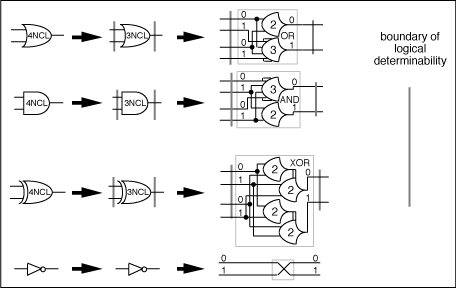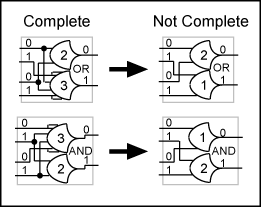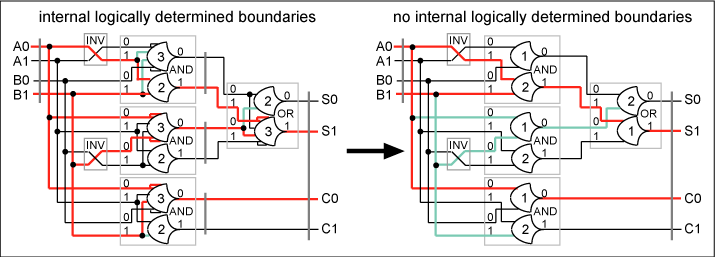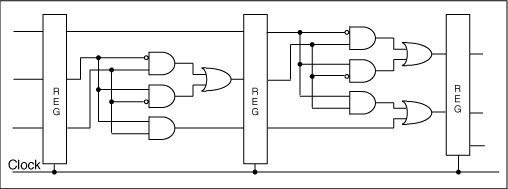2NCL
Expression Unit Functions
2NCL
gates can be composed into expressions that are
not logically determined in any sense at any boundary.
So there must be rules of effective design associated
with 2NCL. Basically a 2NCL expression unit must
enforce the completeness criterion between a variable
level input boundary and variable level output
boundary and must limit orphan signal paths. These
rules can be isolated from the system designer
by providing a library of 2NCL expression units
that are correctly formed and fully logically
determined at their variable level boundaries.
The designer can then freely compose these expression
units into combinational expressions that are
fully logically determined as a whole in exactly
the same sense that 4NCL and 3NCL gates inherently
compose into combinational expressions that are
fully logically determined as a whole. The first
order demonstration of this is the set of expression
units of Figure
15 which is sufficient to map any Boolean
combinational expression into a logically determined
2NCL combinational expression.
The
Fate of Logical Determinability
3NCL
is less logically expressive than 4NCL and 2NCL
is less logically expressive than 3NCL. To form
a complete expression of combinational behavior,
the loss of logical expressivity had to be compensated
with expression about timing relationships among
signals. 4NCL gates are purely combinational gates
and are fully logically determined. 3NCL gates
are logically determined at the gate boundaries
and any logical ambiguity (the feedback path)
is isolated inside the gate. With 2NCL, there
is a multi gate unit of expression between logically
determined boundaries. This expression unit contains
logical ambiguities (orphans) which are isolated
between its logically determined boundaries. Figure
20 shows the boundaries of logical determinability
as logical expressivity is compromised with successively
less expressive logic families.
Figure
20. Logically determined boundary relationships
between NULL Convention Logics.

Further
Compromising Logical Completeness
A
path has been followed of inescapable loss of
logical completeness because of the inadequacies
of successively less expressive logics. One can
also choose to erode logical completeness for
practical reasons. To the extent that one can
make reliable assumptions about expression behavior
one does not need to logically express that behavior.
Of course, all the assumptions must then be made
true in any actual implementation.
While
for 4NCL and 3NCL the logical determinability
of any combination of gates is inherent, this
is not the case for 2NCL. A 2NCL expression must
be properly formed to express the correct completeness
relationships. Less logically determined 2NCL
expressions can be composed erroneously but they
can also be composed deliberately as an engineering
trade-off decision.
One
can choose, for instance, to move the logically
determined completeness boundaries even farther
apart. The 2NCL AND and OR functions can be expressed
with simpler gates that do not express the completeness
criterion. The right-hand expressions of Figure
21 expresses the same data transformation
function as the left-hand expressions of Figure
21 but they can generate an output without
having a complete input data set. The boundaries
of the expressions do not express the completeness
criterion are not logically determined.
Figure
21. 2NCL AND and OR functions that do not enforce
the completeness criterion.

If
these gates are substituted in the expression
in the left-hand side of Figure
22 the result is the right-hand expression
of Figure 22 which contains
simpler logical elements. This circuit preserves
the completeness criterion for the circuit as
a whole but the completeness boundaries are farther
apart and the orphan paths are longer requiring
more precise assumptions about delay relationships.
The reduced logical expressivity necessitates
more expression of temporal relationships to completely
express the process behavior.
Figure
22. 2NCL Half-adder with no internal logically
determined completeness boundaries.

No
Logically Determined Boundaries at All
One
might wish to compromise the logical completeness
of expression to the point where there are no
logically determined boundaries at all in the
data path combinational expressions. If there
are no logically determined completeness boundaries
and the completeness criterion is not in play,
there is little point in using NULL Convention
Logic for the combinational expressions. It would
be more efficient to use the less expressive Boolean
logic.
If
the combinational expressions are not logically
determinable then they must be determined by timing
relationships. One can assume that all combinational
expressions complete their resolution with a given
time period. A single global signal distributed
to each combinational expression expressing the
single time period will suffice. The result is
clocked Boolean logic shown in Figure
23. One must then insure that all combinational
expressions do indeed complete within the allotted
period and that the clock signal is reliably distributed
to all registers.
This
is the form of least logical determinability and
of the most temporal expression. There are no
logically determined completeness boundaries anywhere
in the system.
Figure
23. Clocked Boolean logic.

|